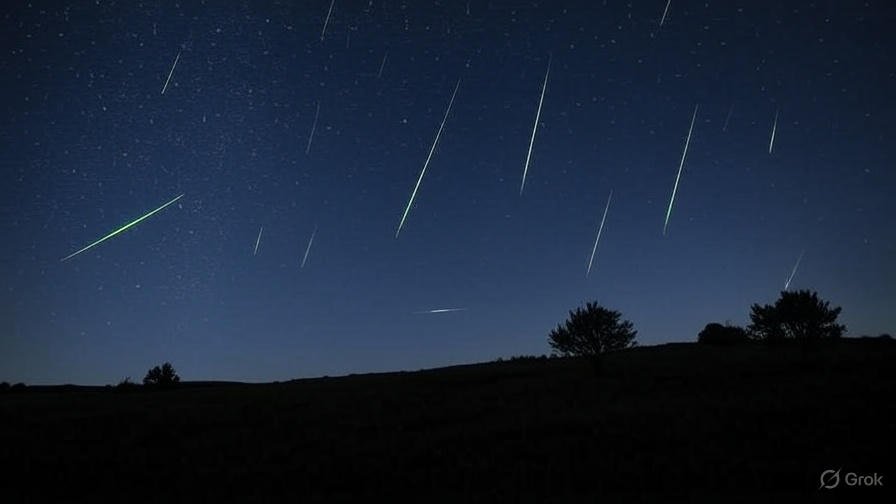Perseid Meteor Shower 2025: Every summer, the night sky puts on a dazzling display that feels like a gift from the universe—the Perseid meteor shower. In 2025, this celestial spectacle promises to light up the skies, though it comes with a bit of a challenge this year. Known for its bright, swift meteors and stunning fireballs, the Perseids are a favorite for stargazers and casual skywatchers alike. Here’s everything you need to know to catch this cosmic event, from when and where to watch to tips for making the most of it.
Table of Contents
What Are the Perseids?
The Perseid meteor shower is one of the most spectacular annual events in the night sky. It happens when Earth passes through the debris trail left by Comet 109P/Swift-Tuttle, a comet that orbits the Sun every 133 years. As tiny bits of dust and rock from the comet hit our atmosphere at speeds up to 130,000 miles per hour, they burn up, creating those brilliant streaks we call “shooting stars.”
- Why it’s special: The Perseids are known for their high meteor rates—up to 100 per hour under perfect conditions—and their vibrant fireballs, which are brighter and longer-lasting than typical meteors.
- Fun fact: The shower is named after the constellation Perseus, where the meteors appear to originate, though you don’t need to focus on Perseus to enjoy the show.
This year, the Perseids are active from July 17 to August 24, with the peak occurring on the night of August 12 into the early morning of August 13. But there’s a catch—moonlight might steal some of the spotlight.
When and Where to Watch in 2025
The Perseids peak on August 12–13, 2025, with the best viewing in the Northern Hemisphere during the pre-dawn hours. Meteors can start appearing as early as 10 p.m., but the show ramps up after midnight, especially just before dawn when the radiant point in Perseus is highest in the sky. Unfortunately, a nearly full moon (84% illuminated on August 12) will wash out fainter meteors, reducing the visible count to about 12–18 per hour, according to the American Meteor Society.
- Best viewing spots: Head to a dark-sky location away from city lights, like a rural park, a countryside field, or a designated dark-sky reserve.
- Alternative dates: For less moonlight interference, try watching from July 24 to July 28, when the moon is less bright, or on August 16–17, when the waning moon rises later, offering darker evening skies.
If you’re in a city, find a spot shielded from streetlights, like a backyard or a park, to improve your chances of spotting those bright fireballs.
Tips for a Great Viewing Experience
To make the most of the Perseids, a little preparation goes a long way. You don’t need fancy equipment—just your eyes, a comfy setup, and some patience. Here’s how to set yourself up for success:
- Find a dark spot: Light pollution is the enemy of meteor watching. Use tools like lightpollutionmap.info to locate dark-sky sites near you.
- Get comfortable: Bring a blanket, reclining chair, or sleeping bag. August nights are warm, but layers are smart for late-night chills.
- Protect your night vision: Avoid bright screens and use a red-light flashlight or app to keep your eyes adjusted to the dark.
- Block the moon: If the moon is up, position yourself behind a tree or building to reduce its glare.
Lie back, look up at a wide patch of sky, and give your eyes 20–30 minutes to adjust. The meteors can appear anywhere, so avoid using telescopes or binoculars, which limit your field of view.

The Moonlight Challenge This Year
The biggest hurdle for the 2025 Perseids is the bright waning gibbous moon, which will be nearly full during the peak. This lunar glow will drown out fainter meteors, making it harder to see the shower’s usual brilliance. NASA notes that only the brightest meteors and fireballs will stand out against the moonlight. Still, don’t let this discourage you—the Perseids are famous for their vivid fireballs, which can outshine the moon and leave smoky trails across the sky.
For the best experience, try watching in the days leading up to the peak when the moon is less intrusive. The shower builds gradually, so late July offers a decent chance to catch some early Perseids without the lunar glare.
A Celestial Bonus: Venus and Jupiter
If you’re out watching the Perseids, you might catch another treat on August 12. Just before dawn, Venus and Jupiter will appear incredibly close together in the morning sky, creating a stunning conjunction. This pairing of the two brightest planets will be a beautiful complement to the meteor shower, especially if you’re up early. Keep an eye out for this cosmic duo low in the eastern sky—it’s a rare sight that adds extra magic to your stargazing night.
Final Thoughts
The Perseid meteor shower is a reminder of how breathtaking our universe can be. Even with the moonlight challenge in 2025, the Perseids offer a chance to connect with the cosmos and witness nature’s own fireworks. Whether you’re a seasoned stargazer or just looking for a reason to spend a night under the stars, this event is worth experiencing. Grab a blanket, find a dark spot, and let the sky put on its show. And if you miss the peak, don’t worry—the shower runs until August 24, and next year’s Perseids in 2026 are predicted to be moon-free and spectacular. So, mark your calendar, gather some friends, and make a night of it. The universe is waiting to dazzle you.